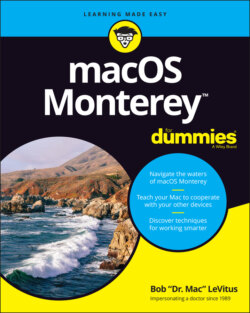Читать книгу macOS Monterey For Dummies - Bob LeVitus - Страница 27
A scroll new world
ОглавлениеYet another way to see more of what’s in a window or pane is to scroll through it. Scroll bars appear at the bottom and right sides of any window or pane that contains more stuff — icons, text, pixels, or whatever — than you can see in the window. Figure 2-2, for example, shows two instances of the same window: Dragging the scroll bar on the right side of the smaller window would reveal the icons above and below the six (whole) icons that are currently visible. Dragging the scroll bar on the bottom of the smaller window would reveal items to the left and right of the six that are currently visible.
FIGURE 2-2: The same window twice. Use the scroll bars in the front window to see the icons above, below, to the left, or to the right.
Simply click and drag a scroll bar to move it up or down or side to side.
If your scroll bars don’t look exactly like the ones in Figure 2-2 or work as described in the following list, don’t worry. These are System Preferences you can configure to your heart’s desire, as you discover in Chapter 6.
Here are some ways you can scroll in a window:
Click a scroll bar and drag. The content of the window scrolls proportionally to how far you drag the scroll bar.
Click in the scroll bar area but don’t click the scroll bar itself. The window scrolls either one page up (if you click above the scroll bar) or down (if you click below the scroll bar). You can change a setting in your General System Preferences pane to cause the window to scroll proportionally to where you click. For what it’s worth, the Page Up and Page Down keys on your keyboard function the same way as clicking the white scroll area (the vertical scroll bar only) in Finder and many applications. These keys don’t work in every program, though, so don’t become too dependent on them. Also, if you purchased a mouse, a trackball, or another pointing device that has a scroll wheel, you can scroll vertically in the active (front) window with the scroll wheel or press and hold down the Shift key to scroll horizontally. Alas, this horizontal scrolling-with-the-Shift-key works in Finder windows but not in all applications. For example, it works in the Apple TextEdit application, but not in Microsoft Word.
Use the keyboard. In Finder, first click an icon in the window and then use the arrow keys to move up, down, left, or right. Using an arrow key selects the next icon in the direction it indicates — and automatically scrolls the window, if necessary. In other programs, you might or might not be able to use the keyboard to scroll. The best advice I can give you is to try it — either it will work or it won’t.
Use a two-finger swipe (on a trackpad). If you have a notebook with a trackpad or use a Magic Trackpad or Magic Mouse, just move the arrow cursor over the window and then swipe the trackpad with two fingers to scroll.
